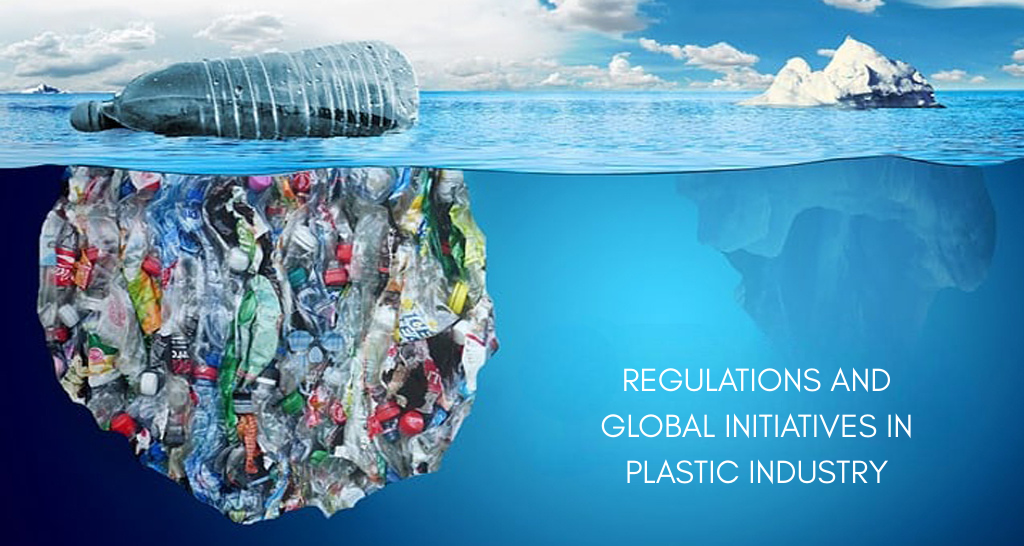Regulations and global initiatives play a pivotal role in shaping the plastic industry by addressing environmental, economic, and public health challenges. These frameworks aim to reduce plastic waste, promote sustainability, and ensure the responsible production and use of plastics. Here’s how regulations and initiatives influence the industry:
1. Reducing Plastic Pollution
A. Regulations on Single-Use Plastics
- Overview:
- Governments worldwide are implementing bans and restrictions on single-use plastics to combat pollution.
- Examples:
- European Union (EU):
- Directive on Single-Use Plastics bans items like plastic straws, cutlery, and plates.
- India: Ban on single-use plastic items like bags, cups, and packaging films.
- United States (State-Level):
- California’s ban on plastic bags and polystyrene food containers.
- European Union (EU):
- Impact:
- Encourages the development and adoption of alternatives like biodegradable or reusable materials.
B. Marine Plastic Pollution Mitigation
- Initiatives:
- Global Partnership on Marine Litter (GPML):
- It aims to prevent marine plastic litter through international collaboration.
- Clean Seas Campaign (UN Environment Programme):
- Encourages governments, businesses, and citizens to reduce plastic waste in oceans.
- Global Partnership on Marine Litter (GPML):
- Impact:
- Promotes awareness, clean-up efforts, and sustainable waste management practices.
2. Encouraging Recycling and Circular Economy
A. Extended Producer Responsibility (EPR)
- Overview:
- Requires manufacturers to take responsibility for the entire lifecycle of their plastic products, including post-consumer waste.
- Examples:
- EU Waste Framework Directive:
- Mandates EPR schemes for packaging waste.
- India:
- Plastic Waste Management Rules include EPR requirements for producers and brand owners.
- EU Waste Framework Directive:
- Impact:
- Drives innovation in product design to improve recyclability.
- Encourages companies to invest in recycling infrastructure.
B. Circular Economy Strategies
- Global Frameworks:
- EU Circular Economy Action Plan:
- Focuses on sustainable design, reduced waste, and increased recycling rates.
- Japan’s Plastic Resource Circulation Act:
- Promotes recycling and the use of recycled materials.
- EU Circular Economy Action Plan:
- Impact:
- Aligns the industry with sustainability goals by reducing reliance on virgin plastics.
3. Promoting Sustainable Materials
A. Incentives for Bio-Based and Biodegradable Plastics
- Regulations:
- Many countries offer tax incentives or subsidies for developing bio-based plastics.
- Examples:
- France:
- Targets to incorporate 60% bio-based plastics in packaging by 2025.
- EU:
- Standards for compostable plastics under EN 13432.
- France:
- Impact:
- Encourages investment in bio-based plastic production and innovation.
B. Global Standards for Sustainable Plastics
- ISO Standards:
- ISO 17088: Specifies requirements for compostable plastics.
- ISO 15270: Guidelines for plastic waste recovery and recycling.
- Impact:
- Provides consistent criteria for industries to develop eco-friendly plastics.
4. Reducing Greenhouse Gas Emissions
A. Regulations on Carbon Footprint
- Initiatives:
- EU Green Deal:
- Targets carbon neutrality by 2050, including reductions in emissions from plastic production.
- Carbon Border Adjustment Mechanism (CBAM):
- Includes plastics in its scope to prevent carbon leakage.
- EU Green Deal:
- Impact:
- Pushes the industry to adopt cleaner production methods and renewable feedstocks.
B. Renewable Energy in Production
- Incentives:
- Policies encourage manufacturers to transition to renewable energy sources in production.
- Impact:
- Reduces energy consumption and carbon footprint in the plastics industry.
5. Managing Microplastics
A. Regulations on Microplastics
- Overview:
- Policies to restrict or ban microplastics in products like cosmetics, detergents, and paints.
- Examples:
- EU: Restricts intentionally added microplastics under the REACH regulation.
- Canada: Ban on microbeads in personal care products.
- Impact:
- Reduces the release of microplastics into the environment.
6. International Cooperation and Agreements
A. Basel Convention
- Overview:
- It was amended in 2019 to include plastic waste under its regulatory framework.
- Objective:
- Ensure environmentally sound management of plastic waste and control transboundary movements.
- Impact:
- Discourages illegal dumping and encourages better waste management systems.
B. UN Plastic Pollution Treaty (Under Negotiation)
- Overview:
- It aims to establish a legally binding global agreement to address plastic pollution.
- Impact:
- Provides a unified global strategy to tackle plastic waste.
7. Addressing Health Concerns
A. Restrictions on Harmful Additives
- Overview:
- Regulations limit or ban the use of toxic additives like phthalates, BPA, and heavy metals.
- Examples:
- EU: Restricts BPA in food contact materials under REACH.
- USA: FDA bans certain phthalates in food packaging.
- Impact:
- Enhances consumer safety and reduces environmental contamination.
8. Industry-Led Initiatives
A. Alliance to End Plastic Waste (AEPW)
- Overview:
- A global initiative by companies in the plastics value chain to reduce waste and improve recycling.
- Impact:
- Investments in waste management infrastructure and innovation.
B. Ellen MacArthur Foundation’s New Plastics Economy
- Overview:
- Promotes the redesign of plastics for a circular economy.
- Goals include eliminating unnecessary plastics and ensuring all plastics are reusable or recyclable.
- Impact:
- Influences industries to adopt sustainable practices.
9. Research and Innovation Incentives
A. Funding for R&D
- Policies:
- Governments and organizations fund research into alternative materials and recycling technologies.
- Examples:
- Horizon Europe provides funding for sustainable plastics research.
- Impact:
- Accelerates the development of innovative solutions for plastic waste.
10. Consumer Awareness and Participation
A. Public Campaigns
- Examples:
- Plastic Free July: Encourages individuals to reduce plastic consumption.
- UNEP’s Clean Seas Campaign: Aims to reduce plastic waste globally.
- Impact:
- Drives consumer demand for sustainable products and responsible disposal.
Challenges in Implementation
- Global Disparities:
- Variability in regulations and enforcement across countries.
- Economic Barriers:
- Higher costs of sustainable alternatives and infrastructure.
- Industry Resistance:
- Resistance from industries dependent on conventional plastics.
Conclusion
Regulations and global initiatives are critical in steering the plastic industry toward sustainability. By addressing plastic pollution, promoting recycling, and encouraging the use of sustainable materials, these frameworks help mitigate the environmental and health impacts of plastics. Continued collaboration among governments, industries, and consumers is essential for creating a sustainable and circular plastics economy.
Hashtags
#PlasticRegulations #GlobalPlasticInitiatives #PlasticWasteRegulations #PlasticPolicy #SustainablePlasticRegulations #GlobalPlasticBans #PlasticWastePolicy #CircularEconomyPolicy #PlasticRegulationStandards #SustainablePackagingPolicy #SustainablePlasticsRegulations #PlasticPollutionRegulations #EcoFriendlyPlasticPolicy #GreenRegulationsInPlastics #PlasticFreeFuture #CorporateSustainability #ESGInPlastics #PlasticWasteManagementPolicy #PlasticCompliance #SustainableBusinessPractices #PlasticRecyclingRegulations #CircularPlasticsRegulations #WasteReductionPolicies #PlasticWasteSolutions #ZeroWastePlastics

















